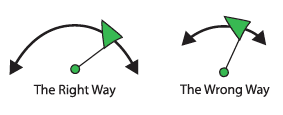Thresholds for lygus bugs and cabbage seedpod weevil, for example, are based on a specific sweep net technique. If you’re not doing a complete 180° pattern, walking while you sweep, and keeping the net near the top of the canopy, your counts could be significantly different from someone using the recommended techniques.
Here are the sweep net techniques outlined in the Canola Council of Canada’s Canola Scouting and Sweep Net Insect Identification Card.
- Use a standard 38 cm diameter net.
- Sample preferably when the foliage is dry. If the foliage is wet small insects may stick to the inside of the sweep net bag making it difficult to identify them and giving you an inaccurate count.
- Hold the net with the hoop end nearest to the ground in front of you. The plane of the hoop should be perpendicular to you.
- Tilt the net opening so the lower edge of the rim is slightly ahead of the upper rim.
- Swing the net from side to side in a full 180-degree arc. Sweep one stroke per step as you casually walk through the field or down the row.
- In short vegetation, swing the net as deeply as possible. In taller vegetation, sweep only deeply enough to keep the upper edge of the sweep net opening even with the top of the plants. In general, don’t let the net go more than 25 cm below the top of the plants.
- Each passage of the net is considered one sweep.

